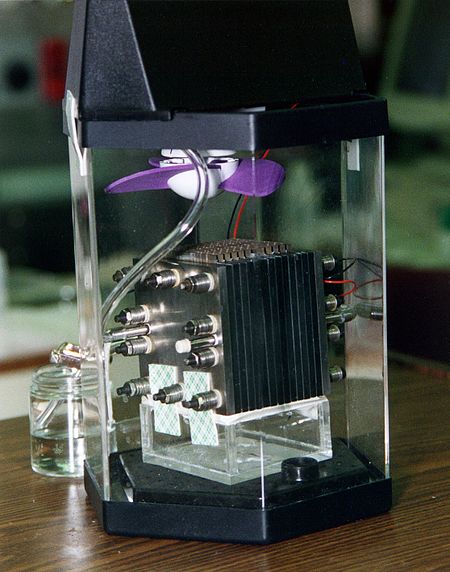CBC-MAC
|
Read other articles:

City in Haifa, IsraelKiryat Ata קִרְיַת אָתָאCity (from 1969)Hebrew transcription(s) • ISO 259Qiryat ʔataˀ • Also spelledQiryat Atta (official)Kiryat Atta (unofficial)Qiryat Ata (unofficial)Qiryat Ata (unofficial) Kiryat AtaShow map of Haifa region of IsraelKiryat AtaShow map of IsraelCoordinates: 32°48′N 35°06′E / 32.800°N 35.100°E / 32.800; 35.100Grid position160/244 PALCountry IsraelDistrict Haifa…

Nobuko MiyamotoMiyamoto dan suaminya Juzo Itami pada 1992Lahir27 Maret 1945 (umur 79)Otaru, Hokkaido, JepangPekerjaanPemeranTahun aktif1966–kiniSuami/istriJuzo Itami (1969–1997)AnakMansaku Ikeuchi Nobuko Miyamoto (宮本 信子code: ja is deprecated , Miyamoto Nobuko, lahir 27 Maret 1945) adalah seorang pemeran asal Jepang. Ia lahir di Otaru, Hokkaidō, dan dibesarkan di Nagoya. Ia menikahi sutradara Juzo Itami dari 1969 sampai kematiannya pada 1997, dan giat tampil dalam film-film…

Crosse d'appontage d'un F/A-18 Hornet ayant accroché un brin d'arrêt La crosse d'appontage, inventée par Hugh Robinson, est un système installé sur les avions embarqués sur des porte-avions. Il s'agit d'une sorte de crochet fixé sous la partie arrière de l'avion, destiné à accrocher un brin d'arrêt lors de l'appontage pour permettre un arrêt sur une très courte distance. Description Premier appontage sur le USS Pennsylvania. La crosse d'appontage est une barre solide en métal …

Прямой метаноловый топливный элемент (англ. Direct-methanol fuel cells, DMFC) —, это разновидность топливного элемента с протонообменной мембраной, в котором топливо, метанол, предварительно не разлагается с выделением водорода, а напрямую используется в топливном элементе. Содержа�…

Historiography Ulysses S. Grant1822 – 1885Portrait by Constant Mayer, 1866 Hundreds of historians and biographers have written biographies and historical accounts about the life of Ulysses S. Grant and his performance in military and presidential affairs. Very few presidential reputations have shifted as dramatically as Grant's. From the time Grant was hailed across the North as the winning general in the American Civil War his military reputation has held up fairly wel…

Château de Gizeux Période ou style Médiéval et Renaissance Type Château de la Loire Début construction XIIIe siècle Fin construction XVIIIe siècle Propriétaire initial Du Bellay (Famille) Destination initiale Château Propriétaire actuel Famille de Laffon Protection Classé MH (1945) Coordonnées 47° 23′ 26″ nord, 0° 12′ 22″ est Pays France Région historique Anjou Région Centre-Val de Loire Département Indre-et-Loire Commu…
Komando Resor Militer 061/Surya KencanaLambang Korem 061/Surya KencanaDibentuk1 September 1949Negara IndonesiaCabangTNI Angkatan DaratTipe unitKorem Tipe APeranSatuan TeritorialBagian dariKodam III/SiliwangiMakoremBogor, Jawa BaratJulukanKorem 061/SKPelindungTentara Nasional IndonesiaMotoWawanen Jeung Wiwaha, Caringcing Bari WaspadaBaret H I J A U Ulang tahun1 SeptemberSitus webkorem061suryakancana.mil.idTokohDanremBrigjen TNI Faisol Izuddin KarimiKepala StafKolonel Inf Dodi Herar…

الدرر السنيةالشعارمعلومات عامةنوع الموقع إسلامي علمي دعوي إعلامي وقفيالوضع الحالي نشطالمنظومة الاقتصاديةالمقر الرئيسي السعوديةأهم الشخصياتالمالك مؤسسة الدرر السنيةتعديل - تعديل مصدري - تعديل ويكي بيانات موقع الدُّرر السَّنيَّة هو موقع إلكتروني إسلامي متخصص في نشر ا�…

هذه المقالة بحاجة لصندوق معلومات. فضلًا ساعد في تحسين هذه المقالة بإضافة صندوق معلومات مخصص إليها. يفتقر محتوى هذه المقالة إلى الاستشهاد بمصادر. فضلاً، ساهم في تطوير هذه المقالة من خلال إضافة مصادر موثوق بها. أي معلومات غير موثقة يمكن التشكيك بها وإزالتها. (أغسطس 2020) هذه المق�…

For non-color displays, see Monochrome. For the color blindness, see Monochromacy. This article may contain an excessive amount of intricate detail that may interest only a particular audience. Please help by spinning off or relocating any relevant information, and removing excessive detail that may be against Wikipedia's inclusion policy. (November 2022) (Learn how and when to remove this message) MonochromFormation1993; 31 years ago (1993)TypeInternational art-technology-phil…

Chroot Informations Type Appel systèmeLogiciel utilitaireConteneur (virtualisation) modifier - modifier le code - voir Wikidata (aide) chroot (change root) est un appel système qui a également donné son nom à une commande des systèmes d'exploitation Unix permettant de changer le répertoire racine d'un processus de la machine hôte. Histoire L'appel système chroot est introduit lors du développement de la version 7 d'Unix en 1979. Il est ajouté à BSD par Bill Joy le 18 mars 1982, 17 mo…

Typeface Comic NeueCategoryScriptDesigner(s)Craig Rozynski with Hrant PapazianDate releasedApril 2014LicenseSIL OFLDesign based onComic SansVariationsComic Neue AngularWebsitecomicneue.com Comic Neue is a casual script typeface released in 2014. It was designed by Craig Rozynski with Hrant Papazian as a more modern, refined version of the ubiquitous, but often criticized typeface Comic Sans.[1][2] Design Comparison of Comic Sans and Comic Neue; in creating the new typeface, Rozyn…

Town located in Chūō-ku, Tokyo For the brand of radio equipment, see Yaesu (brand). GranTokyo North Tower Yaesu (八重洲) is a district in Chūō, Tokyo, Japan, located north of Ginza, west of Nihonbashi and Kyōbashi, and adjacent to the east side of Tokyo Station. The Yaesu exit of this station, which faces Nihonbashi, is recent and primarily provides access to the Shinkansen platforms. History GranRoof The area was named after the 17th century Dutch adventurer Jan Joosten van Lodensteijn,…

Synthetic cannabinoid HU-210Clinical dataOther names1,1-Dimethylheptyl- 11-hydroxy- tetrahydrocannabinolLegal statusLegal status CA: Schedule II UK: Class B US: Schedule I[1] Identifiers IUPAC name (6aR,10aR)-9-(hydroxymethyl)-6,6-dimethyl-3-(2-methyloctan-2-yl)-6H,6aH,7H,10H,10aH-benzo[c]isochromen-1-ol CAS Number112830-95-2 YPubChem CID9821569IUPHAR/BPS731ChemSpider7997318 NUNII191042422PChEMBLChEMBL307696 NCompTox Dashboard (EPA)DTXSID30150188 Chemical an…

American politically conservative mass media company For a municipality's chief administrative building, see Town hall. For other uses, see Town Hall (disambiguation). This article needs additional citations for verification. Please help improve this article by adding citations to reliable sources. Unsourced material may be challenged and removed.Find sources: Townhall – news · newspapers · books · scholar · JSTOR (June 2021) (Learn how and when to remove…

HattemMunicipalityThe city hall of Hattem BenderaLambang kebesaranCountryNetherlandsProvinceGelderlandLuas(2006) • Total24,20 km2 (930 sq mi) • Luas daratan23,12 km2 (893 sq mi) • Luas perairan1,08 km2 (42 sq mi)Populasi (1 January, 2010) • Total11.797 • Kepadatan503/km2 (1,300/sq mi) Source: CBS, Statline.Zona waktuUTC+1 (CET) • Musim panas (DST)UTC+2 (CEST) Hattem…

Euro Beach Soccer League 2017 Competizione Euro Beach Soccer League Sport Calcio da spiaggia Edizione 20ª Date dal 23 giugnoal 17 settembre Luogo Europa Partecipanti 27 Risultati Vincitore Russia(5º titolo) Secondo Portogallo Terzo Italia Quarto Spagna Statistiche Miglior giocatore Artur Paporotnyi Miglior marcatore Dejan Stankovic (18) Miglior portiere Maksim Chuzkhov Incontri disputati 89 Gol segnati 727 (8,17 per incontro) Cronologia della competizione 2016…

British businesswoman (born 1959) Deborah MeadenMeaden after a BBC's Dragons' Den appearance, 2011BornDeborah Sonia Charles (1959-02-11) 11 February 1959 (age 65)Taunton, Somerset, EnglandNationalityBritishEducationTrowbridge High SchoolAlma materBrighton Technical CollegeOccupationBusinesswomanKnown forDragons' DenStrictly Come DancingSpouse Paul Farmer (m. 1993)Websitedeborahmeaden.com Deborah Sonia Meaden (born 11 February 1959)[1][2&#…

This article has multiple issues. Please help improve it or discuss these issues on the talk page. (Learn how and when to remove these template messages) This article is an orphan, as no other articles link to it. Please introduce links to this page from related articles; try the Find link tool for suggestions. (August 2023) This biography of a living person needs additional citations for verification. Please help by adding reliable sources. Contentious material about living persons that is unso…

Valley in West Yorkshire, England 53°43′12″N 2°00′14″W / 53.720°N 2.004°W / 53.720; -2.004 Upper Calder Valley, West Yorkshire The Upper Calder Valley lies in West Yorkshire, in northern England, and covers the towns of Todmorden, Hebden Bridge, Mytholmroyd, Luddendenfoot, and Sowerby Bridge, as well as a number of smaller settlements such as Portsmouth, Cornholme, Walsden, and Eastwood. The valley is the upper valley of the River Calder. Major tributaries of …







![{\displaystyle m''=m\|[(m_{1}'\oplus t)\|m_{2}'\|\dots \|m_{x}']}](https://wikimedia.org/api/rest_v1/media/math/render/svg/d2359189c7c2c4e8e203758741488322c77d97a2)




































